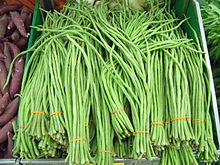- Vigna unguiculata subsp. sesquipedalis
-
Yardlong bean Scientific classification Kingdom: Plantae (unranked): Angiosperms (unranked): Eudicots (unranked): Rosids Order: Fabales Family: Fabaceae Subfamily: Faboideae Genus: Vigna Species: V. unguiculata Subspecies: V. u. subsp. sesquipedalis Trinomial name Vigna unguiculata subsp. sesquipedalis
(L.) Verdc."Asparagus bean" redirects here. For actual asparagus plant, see Asparagus.Vigna unguiculata subsp. sesquipedalis, the yardlong bean, is also known as bora, the long-podded cowpea, asparagus bean, snake bean, or Chinese long bean. It is known as dau gok in Cantonese, jiang dou (豇豆) in Standard Chinese, thua fak yao (ถั่วฝักยาว) in Thai and kacang panjang in Indonesian and Malay, 'SITAO' or 'SITAW' in Tagalog, utong in Ilokano, bora or bodi in the West Indies and vali, Borboti in Bengali, India, eeril in Goa, India or đậu đũa (Vietnamese, literally: chopstick bean), ju-roku sasage (十六ササゲ) in Japan. Despite the name, the pods are actually only about half a yard long; the subspecies name sesquipedalis (one-and-a-half-foot-long) is a rather exact approximation of the pods' length.
This plant is of a different genus than the common bean. It is a vigorous climbing annual vine. A variety of the cowpea, it is grown primarily for its strikingly long (35-75 cm) immature pods and has uses very similar to that of the green bean. The pods, which begin to form just 60 days after sowing, hang in pairs. They are best for vegetable use if picked before they reach full maturity. The plant is subtropical/tropical and most widely grown in the warmer parts of Southeastern Asia, Thailand, and Southern China. Yardlong beans are quick-growing and daily checking/harvesting is often a necessity. The many varieties of yardlong beans are usually distinguished by the different colors of their mature seeds. A traditional food plant in Africa, this little-known vegetable has potential to improve nutrition, boost food security, foster rural development and support sustainable landcare.[1]
Contents
Uses
The crisp, tender pods are eaten both fresh and cooked. They are at their best when young and slender. They are sometimes cut into short sections for cooking uses. As a West Indian dish it is often stir-fried with potatoes and shrimp. They are used in stir-fries in Chinese cuisine. In Malaysian cuisine they are often stir-fried with chillies and shrimp paste (sambal) or used in cooked salads (kerabu). Another popular and healthful option is to chop them into very short sections and fry them in an omelette.
Nutrition
They are a good source of protein, vitamin A, thiamin, riboflavin, iron, phosphorus, and potassium, and a very good source for vitamin C, folate, magnesium, and manganese.
Yard long beans (raw) Nutritional value per 100 g (3.5 oz) Energy 196 kJ (47 kcal) Carbohydrates 8 g - Dietary fibre 3.6 g Fat 0 g Protein 3 g Percentages are relative to US recommendations for adults.
Source: USDA Nutrient DatabaseIn a serving size of 100 grams of yardlong beans there are 47 calories, 0 grams of total fat, 0 mg cholesterol, 4 mg sodium (0% daily value), 8 grams of total carbohydrates (2% daily value), and 3 grams of protein (5% daily value). There is also 17% DV vitamin A, 2% DV iron, 31% DV vitamin C, and 5% DV calcium. (Percent daily values are based on a 2000 calorie diet. Individual daily values may be higher or lower depending on individual calorie needs.)
See also
- List of Thai ingredients
References
- ^ National Research Council (2006-10-27). "Long Bean". Lost Crops of Africa: Volume II: Vegetables. Lost Crops of Africa. 2. National Academies Press. ISBN 978-0-309-10333-6. http://books.nap.edu/openbook.php?record_id=11763&page=223. Retrieved 2008-07-15.
External links
Categories:- Fruit vegetables
- Edible legumes
- Vigna
- Japanese ingredients
- Thai ingredients
- Malaysian ingredients
- Lao ingredients
- Vietnamese ingredients
Wikimedia Foundation. 2010.




